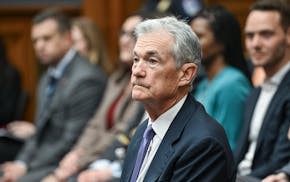On a day when several national retail chains posted glum results for their most important quarter of the year, Target Corp. fared mildly better, despite its 41 percent drop in quarterly earnings. But without a huge dose of consumer optimism to open up wallets again, the discount chain is preparing for lean times ahead by reeling in store expansions, its workforce, the money it lends consumers -- and expectations.
The Minneapolis-based company's bottom line took a one-two punch from consumers during the holidays, as shoppers bought fewer high-margin discretionary goods, such as clothing and home furnishings, and growing numbers of credit card holders failed to pay their bills.
Expenses related to bad credit-card debt tripled during the fourth quarter and helped drag down profits, the Minneapolis-based discount retail chain said Tuesday. Net income for the period, which ended Jan. 31, was $609 million, or 81 cents a share, below analysts' expectations. A year ago, the company posted income of $1.03 billion, or $1.23 a share.
"Investors were very surprised by the level of bad debt reserves and nervous about what that signals for write-off activity in 2009," said Piper Jaffray analyst Jeff Klinefelter. "Given the very weak signals we're getting from consumer confidence and other macroeconomic factors, it stands to reason these write-offs will continue to accelerate."
The company's credit card portfolio, once a strong contributor to profits, took a $135 million pretax loss for the quarter. In the same period last year, Target recorded a profit of $189 million. While write-offs continued to increase, so did delinquent accounts, a sign of even more trouble ahead.
CEO Gregg Steinhafel told analysts in a morning conference call that the pace of the write-offs for bad debt were higher than even company officials had expected. The company will beef up its reserves to prepare for more write-offs in the coming year, he said.
Retailers nationwide are struggling with record-low consumer confidence. Discounters such as Wal-Mart, Costco, Dollar Store and others are faring much better as consumers seek rock-bottom prices on essentials. But department stores and clothing retailers are getting socked even harder. Macy's reported a fourth-quarter drop in profit of 59 percent on Tuesday, and upscale chain Nordstrom's profits took a 68 percent tumble earlier in the week.
"Office companies, consumer electronics ... apparel stores, sporting goods, hard goods, soft goods" all are feeling the unprecedented slowdown in consumer spending, said David Heupel, a portfolio manager with Thrivent Financial.
"There really isn't a place to hide other than value-oriented stores, and, unfortunately, that's not where Target's strength lies," he said.
Target distinguishes itself from its low-frills competitors with its higher mix of home accessories, furniture and apparel. Though Heupel said Thrivent's research shows that a basket of goods at Target is only 5 to 7 percent higher than Wal-Mart, "any variance in the perception of consumers is too much. That's what [Target is] trying to address."
Target has taken the rare step of putting prices in its television ads, and has been aggressively promoting grocery deals in redesigned newspaper circulars. Its new store prototype, which adds more food, health care and beauty items, now makes up about half of its general merchandise stores, the company said Tuesday. Going forward, all new stores and remodels will be designed with the company's growing grocery segment in mind.
The new prototype "is very well-timed for this economic cycle," said Piper Jaffray's Klinefelter, who said that despite the grim news Target "still is a great business model for recessionary periods."
Hawaii to get two stores
Target opened 91 new stores in 2008, not including those that were relocated or remodeled. Steinhafel said the company would cut that amount by a third, and open about 60 new stores, including its first two stores in Hawaii. Looking into 2010, the company is being even more conservative, saying it may only open five to 30 stores.
Revenue was $19.56 billion for the fourth quarter, down 1.6 percent from a year earlier. Sales among stores open more than a year, a key measure of a retail chain's health, dropped almost 6 percent for the quarter.
For the year, Target's net income fell about 22 percent to $2.85 billion, or $2.86 a share. Annual sales grew 2.3 percent, to $62.88 billion.
Target stock, already hovering near multiyear lows, fell another 2 percent Tuesday to close at $27.83.
Although the company did not provide specific guidance for 2009, Chief Financial Officer Doug Scovanner indicated that the majority of analysts had higher expectations than what the company has laid out to date.
Steinhafel said that Target would focus on becoming more efficient but that it would "not take action that will damage our brand in pursuit of a short-run decrease in expenses."
Last month, Target announced it would reduce its workforce by 9 percent, which included laying off 600 headquarters employees and leaving another 400 posts unfilled.
Jackie Crosby • 612-673-7335

Fed's Powell: Elevated inflation will likely delay rate cuts this year
Participant, studio behind 'Spotlight,' 'An Inconvenient Truth,' shutters after 20 years

